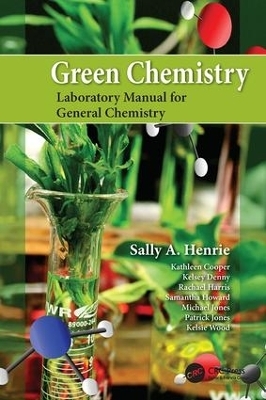
Green Chemistry Laboratory Manual for General Chemistry
CRC Press (Verlag)
978-1-138-41024-4 (ISBN)
Following a consistent format, each lab experiment begins with objectives and prelab questions highlighting important issues that must be understood prior to getting started. This is followed by detailed step-by-step procedures for performing the experiments. Students report specific results in sections designated for data, observations, and calculations. Once each experiment is completed, analysis questions test students comprehension of the results. Additional questions encourage inquiry-based investigations and further research about how green chemistry principles compare with traditional, more hazardous experimental methods. By placing the learned concepts within the larger context of green chemistry principles, the lab manual enables students to see how these principles can be applied to real-world issues.
Performing laboratory exercises through green experiments results in a safer learning environment, limits the quantity of hazardous waste generated, and reduces the cost for chemicals and waste disposal. Students using this manual will gain a greater appreciation for green chemistry principles and the possibilities for future use in their chosen careers.
Sally A. Henrie is a professor of chemistry at Union University in Jackson, Tennessee, and has been in chemical education for over 16 years. Dr. Henrie has taught various courses and laboratories, including Fundamentals of Chemistry, General Chemistry Laboratory, Organic Chemistry, Organic/Inorganic Synthesis, Survey of Chemical Instrumentation, Advanced Organic Chemistry, and Environmental Chemistry. She is also involved in mentoring undergraduate research students in chemical education and dendrimer research. Dr. Henrie previously worked as a junior research chemist for Phelps Dodge Corporation, plant chemist for Mount Pleasant Chemical Company, and materials lab supervisor/process engineer for Whirlpool Corporation. While working in industry, she contributed to various environmentally related projects.
Determining the percent of water in epsom salt. Determination of the formula of a copper supplement. Determination of mass and mole relationships in a chemical reaction. Finding ethanol's molar mass using vapor density. Determining molar volume of a gas at standard temperature and pressure. Determining the enthalpy change for solvation reactions. Spectroscopic determination of food dye in popsicles. Separation of food dyes by paper chromatography. What is the best solution to lower a freezing point? Standardization of a sodium hydroxide solution. Determining the amount of acid in ketchup and hot sauce. Using an appropriate indicator for acid-base titrations. Preparation and properties of buffer solutions. Determination of the rate of reaction and its order. Equilibrium constant for ferric ion-salicylic acid complex determination. Determination of amount of ascorbic acid in a vitamin C tablet by redox titration. Qualitative analysis of metal cations and using ion-selective electrodes. How to determine the order of an electrochemical series. Voltaic cells and how batteries are made. Synthesis and chemical analysis of sodium iron (III) EDTA. Analysis of biodiesel synthesized from canola oil.
| Erscheinungsdatum | 05.09.2017 |
|---|---|
| Verlagsort | London |
| Sprache | englisch |
| Maße | 156 x 234 mm |
| Gewicht | 453 g |
| Themenwelt | Medizin / Pharmazie ► Medizinische Fachgebiete ► Arbeits- / Sozial- / Umweltmedizin |
| Studium ► Querschnittsbereiche ► Klinische Umweltmedizin | |
| Naturwissenschaften ► Biologie | |
| Naturwissenschaften ► Chemie | |
| Technik ► Elektrotechnik / Energietechnik | |
| Technik ► Umwelttechnik / Biotechnologie | |
| ISBN-10 | 1-138-41024-1 / 1138410241 |
| ISBN-13 | 978-1-138-41024-4 / 9781138410244 |
| Zustand | Neuware |
| Haben Sie eine Frage zum Produkt? |
aus dem Bereich


